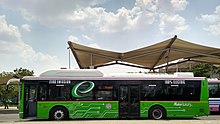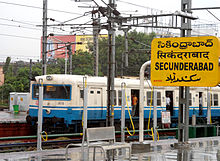Hyderabad, the capital and largest city of Telangana, features a growing transportation infrastructure that includes a network of roads, railways, and a developing rapid transit system. These transportation systems play a crucial role in connecting the city's residents and facilitating efficient travel within Hyderabad and its surrounding areas. Furthermore, Hyderabad serves as a significant center for transportation and logistics, playing a crucial role in facilitating the seamless movement of goods and services within the state.[1]
| Transport in Hyderabad | |
|---|---|
| Overview | |
| Locale | Hyderabad and surrounding regions |
| Transit type | Rapid transit, commuter rail, buses, private automobile, pedestrian |

Road
Hyderabad is integrated into the National Highway Network of India through NH 44, NH 65, NH 163, NH 765, NH 765D,[2] while four State Highways SH1, SH4, SH 6, SH 19 originate/terminate in Hyderabad.[citation needed] Hyderabad has a vehicle population of nearly 48 lakhs and is the highest after Delhi, Bengaluru, Chennai and Mumbai.
The first Expressway in Hyderabad connecting Mehdipatnam and Aramgarh opened for public in 2009 to ease connectivity to Rajiv Gandhi International Airport[3] located in Shamshabad, and named after the former Prime Minister P V Narsimha Rao. An extension of this Expressway further to Shamshabad was mulled in 2018.[4][5]
The Road Network in Hyderabad is characterised by a concentric network of Inner Ring Road and Outer Ring Road. The latter is an expressway stretching 158 km, built to provide orbital linkage between arterial radial roads within the city, as well as to offer connectivity the National Highways.[6]
Bus
Telangana State Road Transport Corporation


Hyderabad has an extensive intracity, intercity/regional and interstate bus service network operated by TSRTC, backed by the Government of Telangana. Within the municipal limits of the city, TSRTC plies intercity and interstate buses from Mahatma Gandhi Bus Station, Uppal Bus Station, Charminar Bus Station, Dilsukhnagar Bus Station, Koti Bus Station, Rathifile Bus Station, Ghatkesar Bus Station, Afzalgunj Bus Station, Medchal Bus Station, Sanathnagar Bus Station, ECIL Bus Station and Secretariat.[7]
City buses are deployed from their respective depots which shall have jurisdiction over the staffing and frequency of services. City and Suburban buses constitute the primary mode of transport in Hyderabad.
TSRTC has several kinds of services which differ in comfort, price and the number of stops:[8]
- Metro Luxury (air-conditioned)
- City Sheetal (air-conditioned)
- Metro Deluxe[9]
- Metro Express Low Floor (non air-conditioned)
- Metro Express
- City Ordinary
- Pushpak (for Airport Connectivity, air-conditioned).[10] electric buses are used in this airport bus service.[11]
Setwin
The State Government of Telangana (erstwhile Andhra Pradesh) sanctioned[12] minibuses as a self-employment generation scheme which ply between different parts of the city in addition to the city buses run by TSRTC.
Taxis
Metered Auto Rickshaw usually referred to as an "auto", is another widely available taxi in Hyderabad. Shared 'auto' taxis are also a commonplace in Hyderabad. Mandatory Metering is contentious issue between passengers, service providers and the authorities.[13][14]
Vehicle for hire companies in Hyderabad include Uber, Ola Cabs, and taxicabs.
Rail
South Central Railway, a zone of Indian Railways, has its headquarters located in Secunderabad.[15] In addition to offering inter-city connectivity, this zone provides sub-urban commuter transportation services in Hyderabad and Secunderabad through Multi-Modal Transport System. In addition to the MMTS, Hyderabad has a growing rapid transit connectivity in the form of a metro system. The metro network provides links to key areas within the city, enhancing transportation options for residents and improving connectivity.
Multi-Modal Transport System

Hyderabad has a commuter transportation system known as the Multi Modal Transport System (MMTS), connecting various suburbs of Hyderabad.
However, MMTS Services, despite the load factors, have been criticised for lack of adequate frequency and inordinate delays.[16] Extension to the current project has been sought through the launch of Phase-II,[17] albeit with limited success of approval.[18][19]
Metro

Hyderabad Metro Rail, the Elevated[20] Mass Rapid Transit System of Hyderabad, started operations in 2017.Currently Hyderabad Metro carries more than 3 lakh people per day.[21][22][23][24] The initial phase of operation was 30 km long,[25][26] connecting Nagole and Miyapur, over two corridors through Ameerpet Interchange Station.[27][28][29]
The placement of Metro Stations across the city have been geared to feed the existing transport systems.[30] It was however, criticised for inability to achieve its objectives,[31][32] low frequency[33] and high fares.[34] The frequency of the services increased further since launch to address the shortage of frequency.[35][36][37]
To further connectivity, HMRL tied up with Uber, to set up booking kiosks across stations.[38][39][40][41] Further, bicycle facility was launched on a limited scale.[42][43][44]
Air


In 1935, Hyderabad's Hakimpet air base was linked with international flight services.[45] The new and modern airport at Shamshabad replaced old Begumpet Airport, on 23 March 2008. As of 2010, The Rajiv Gandhi International Airport at Shamshabad has been judged among the world's top airports in the category of serving 5–15 million passengers, according to Airports Council International,[46] and the world's fifth best airport, according to Skytrax.[47] The airport has one of the longest runway (4260 metres) in India,[48] and caters to high passenger and cargo volumes. In January 2011, it became India's first airport to transport more than 30,000 tonnes (66,000,000 lb) of temperature-controlled pharmaceutical products.[49] It is the primary base for SpiceJet's fleet of Bombardier Dash 8s.[50] GMR Hyderabad International Airport Limited, which operates the airport, has been awarded the Center for Asia Pacific Aviation award in the category of Best Airport Environmental Performance of the Year 2009.[51]
The airport is connected to the city by three major roads.[52] The 11.6-kilometre (7.2 mi) Hyderabad Elevated Expressway provides dedicated high-speed travel to the airport. As of 2011, it is the longest expressway in India.[53] The Nehru Outer Ring Road serves as a controlled-access expressway between Gachibowli and Shamshabad.[52] Metered taxis and buses are available as transports to the airport.[54]
Hyderabad is connected with direct flights to all major destinations in India, as well as to various locations in Middle East, Southeast Asia, Europe and North America. Currently, Hyderabad has flights connecting either directly or intermediate stops to foreign cities like Frankfurt, Singapore, Dubai, Bangkok, Kuala Lumpur, Dammam, Chicago (O'Hare), London (Heathrow), Doha, Jeddah, Muscat, Riyadh and Kuwait.
References
External links

